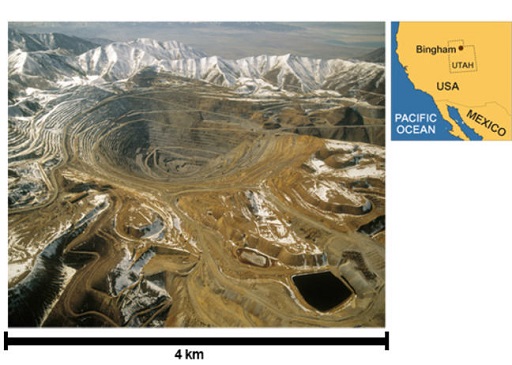2.12 Porphyry ore deposits
Porphyry is a textural term, describing an intrusive igneous rock that has large crystals, which are themselves surrounded by smaller crystals. Remember, an igneous rock is one that has cooled down from a molten (liquid) state, and an intrusive igneous rock is one that has cooled down within the earth, surrounded by other rocks. In a case like this, the smaller crystals are called the matrix or groundmass.
Porphyry ore deposits are low grade – meaning that the amount of the element that you want (in this case, copper) isn’t very high. Porphyry deposits can, however, be very large, so by extracting and processing very large amounts of low grade ore, enough copper can be found for it to be economically worthwhile.
The need to remove very large amounts of very hard igneous rocks means that porphyry ore deposits weren’t mined at all until 1905, when powered shovels and rail transport for the unprocessed ore made them viable. Figure 2.13 shows the Bingham Canyon open pit mine in Utah – you certainly wouldn’t have wanted to dig such a big hole with only shovels and picks!
The Bingham Canyon mine was one of the first porphyry copper deposits to be mined, and it’s still one of the largest known ore deposits in the world. The ore body is about 2.5 km long, 1.7 km wide and over 1 km deep. More than a billion tonnes (that’s 1,000,000,000,000 kg – a petagram!) of ore has been mined, with an average yield of only 0.9% copper. This means that 9 billion kg of copper has been extracted from the Bingham Canyon mine so far.
They’re not even half way – there’s a reserve of 1.7 billion tonnes still to go, which has enough copper to be economically worthwhile (the lower limit at Bingham is about 0.7% for it to be worth extracting).


